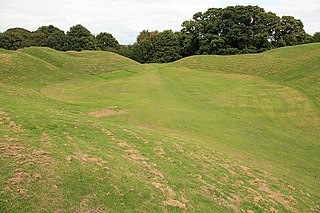
Roman Britain was the territory that became the Roman Province of Britannia after the Roman conquest of Britain, consisting of a large part of the island of Great Britain. The occupation lasted from AD 43 to AD 410.

Dame Kathleen Mary Kenyon, was a British archaeologist of Neolithic culture in the Fertile Crescent. She led excavations of Tell es-Sultan, the site of ancient Jericho, from 1952 to 1958, and has been called one of the most influential archaeologists of the 20th century. She was Principal of St Hugh's College, Oxford, from 1962 to 1973, having undertaken her own studies at Somerville College, Oxford.

Calleva Atrebatum was an Iron Age oppidum, the capital of the Atrebates tribe. It then became a walled town in the Roman province of Britannia, at a major crossroads of the roads of southern Britain.

Silchester is a village and civil parish about 5 miles (8 km) north of Basingstoke in Hampshire. It is adjacent to the county boundary with Berkshire and about 9 miles (14 km) south-west of Reading.

Sheppard Sunderland Frere, CBE, FSA, FBA was a British historian and archaeologist who studied the Roman Empire. He was a fellow at All Souls College, Oxford.

Martin John Millett, is a British archaeologist and academic. From 2001 to 2022, he was the Laurence Professor of Classical Archaeology at the University of Cambridge and a professorial fellow of Fitzwilliam College, Cambridge. Since 2021, he has been president of the Society of Antiquaries of London.

The Society for the Promotion of Roman Studies was founded in 1910 as the sister society to the Society for the Promotion of Hellenic Studies.

Black-burnished ware is a type of Romano-British ceramic. Burnishing is a pottery treatment in which the surface of the pot is polished, using a hard smooth surface. The classification includes two entirely different pottery types which share many stylistic characteristics. Black burnished ware 1 (BB1), is a black, coarse and gritty fabric. Vessels are hand made. Black burnished ware 2 (BB2) is a finer, grey-coloured, wheel thrown fabric.

Cirencester Amphitheatre was a Roman amphitheatre in Cirencester, Gloucestershire, England. Its remains are scheduled as an ancient monument.
Sir Ian Archibald Richmond, was an English archaeologist and academic. He was Professor of the Archaeology of the Roman Empire at the University of Oxford. In addition, he was Director of the British School at Rome from 1930 to 1932, President of the Society for the Promotion of Roman Studies from 1958 to 1961, and Director of the Society of Antiquaries of London from 1959 to 1964.

The Silchester Ogham stone is a pillar stone discovered at the Roman town on Calleva Atrebatum in Silchester, Hampshire during excavations in 1893. Thus far it remains the only one of its kind found in England, and the only ogham inscription in England east of Cornwall and Devon. The stone is held in a storage facility of Reading Museum in Reading, Berkshire.
Hella Eckardt is an archaeologist who specialises in Roman archaeology and material culture and a professor at the University of Reading. Since 2018 she has been the Editor of the journal Britannia.

Lisa Ann Lodwick was a British archaeologist who studied charred, mineralised and waterlogged macroscopic plant remains, and used carbon and nitrogen stable isotope analysis to understand the crop husbandry practices of the ancient Romans.
Alex Mullen is an ancient historian, sociolinguist and Roman archaeologist. She is currently an associate professor in Classical Studies at the University of Nottingham and a fellow of All Souls College, Oxford.
John Creighton is a British archaeologist and assistant professor at the University of Reading. His research focuses on the Late Iron Age and Early Roman period of north-western Europe.
Britannia is an annual peer-reviewed academic journal published by Cambridge University Press on behalf of the Society for the Promotion of Roman Studies. It was established in 1970 and the first editor-in-chief was Sheppard Frere. The journal covers research on the province of Roman Britain, Iron Age and post-Roman Britain, and western provincial archaeology, as well as excavation reports. It was established because of the large increase in archaeological excavations, increased publication costs, and in order to establish coherence to the field of Roman Britain.
Jennifer Foster is an English scholar of prehistoric and medieval archaeology, who specializes in the study of artifacts, particularly metalwork.
Nina Crummy is a British archaeologist and artefact specialist, especially of Roman material culture.
Dr Ruth Shaffrey is an archaeologist.
Ian Mathieson Stead is a British archaeologist and curator, specialising in the British Iron Age.












